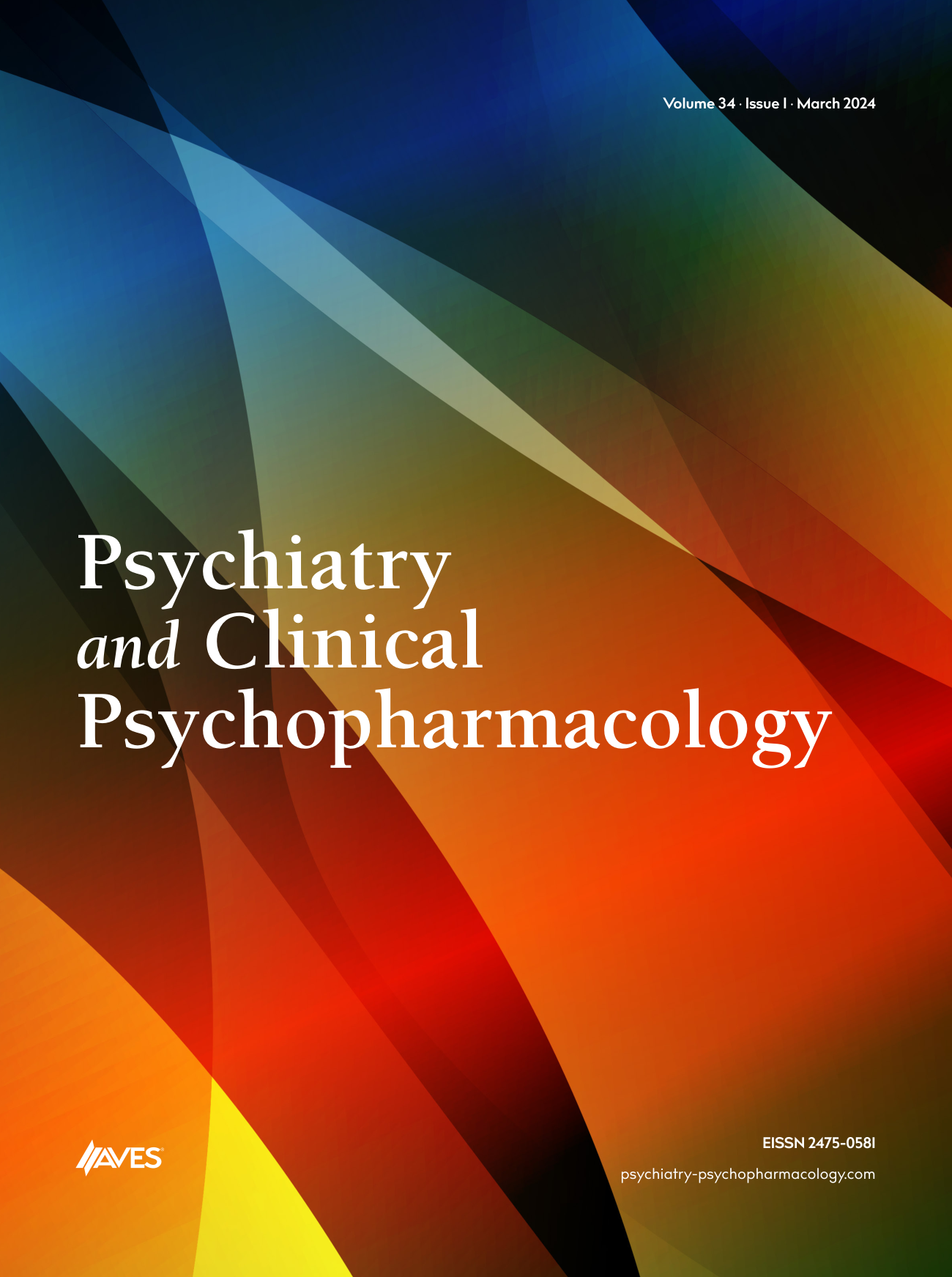INTRODUCTION: Major depressive disorder (MDD) is one of the most prevalent psychiatric disorders, which leads to significant social and economic burden across the world. One way to increase knowledge about pathophysiology is to understand how the pre-disease state processes to the disease state. The pre-disease state can be best studied in the high-risk populations who have higher chance of proceeding to disease. First degree relatives especially the offspring of patients are accepted as high-risk groups. Researchers were able to observe structural and functional abnormalities in the high-risk groups. Miskowiak et al observed increased anterior cingulate and dorsomedial prefrontal cortexes, pre-supplementary motor area with parietooccipital areas activation to happy or fearful faces in healthy twins with a co-twin history of depression1 . On the other hand, Chen et al reported reduced hippocampal volume in girls of depressed mothers2 . The primary aim of this study was to investigate the cortical grey matter volume alterations in young women who were at risk for familial depression. The secondary aim was to perceive if those alterations were parallel with their MDD diagnosed mothers.
METHOD:
Subjects: After approval by the Ethics Committee of Ege University and the recruitment via Internet advertisements and by invitation from the hospital database between 2009-2013, we screened 53 pairs of depressed mothers with their daughters. Among these pairs, 24 women with the diagnosis of MDD with recurrent episodes (mean age: 46.2±3.9 years) and their healthy daughters (the high-risk for familial depression group; HRFD) aged between 18-26 (mean age: 22.3±2.1 years) were included. The recurrent MDD diagnoses weremconfirmed by Structured Clinical Interview for DSM-4 (SCID). iInclusion criteria for the MDD mothers were; being free from clinically significant depression (Hamilton Depression Rating Scale (HAM-D)<16), having no other axis I diagnoses, having at least one healthy daughter with no history of depression between the ages 18-25, having a first-degree relative with an MDD diagnosis, having no history of psychotic symptoms. Patients with chronic medical illness and those who had relatives with bipolar disorder or schizophrenia were excluded. The control group was composed of age similar 24 healthy mothers (mean age: 47.3±5.6 years) who had healthy daughters of similar ages (mean age: 22.1±2.1 years) to the high-risk group. The healthy daughters of the control group constituted the low-risk for familial depression group (LRFD). Exclusion criteria for control groups were; any current or past psychiatric disorder confirmed with SCID, having any first-degree relative diagnosed with major depression, bipolar disorder or schizophrenia, having a chronic medical illness, having significant childhood trauma (e.g. sexual or physical abuse). Mothers and daughters gave their written informed consent after receiving a full explanation of the study’s purpose and procedures. Mothers in the MDD group continued their ongoing treatment and no treatment modification was done for this study. Depressive symptoms were assessed by HAM-D and Beck Depression rating scales on the same week for MRI scan.
MRI Acquisition: 3D T1 weighted, sagittal, magnetization prepared rapid gradient echo (MPRAGE) scans of the head, 2D T2 weighted axial, Turbo Spin Echo (TSE) scans of the whole brain and 3D coronal fluid attenuated inversion recovery (FLAIR) scans were acquired on a Siemens Magnetom Verio, Numaris/4, Syngo MR B17, 3T MR scanner. TSE and FLAIR scans were used for clinical evaluation and MPRAGE scans were used in the region of interest (ROI) analysis.
Image Processing: For image processing we used FreeSurfer Software and it’s recommended mainstream pipeline to segment gray matter volumes.
Statistics: Sociodemographic and clinical variables were compared by t- or chi-square tests for MDD vs Controls and HRFD vs LRFD separately. Analyses of co-variance (ANCOVA) were used to compare the grey matter volume in each ROI. Total Intracranial Volume (ICV) was accepted nuisance variable for ANCOVA analyses. Due to multiple comparisons, we reported both uncorrected and false discovery rate (FDR) corrected p values adjusted to 0.05. The correlation between grey matter volumes in ROIs with clinical parameters were assessed by Pearson correlation test.
RESULTS:
Sociodemographic and Clinical Variables: There were no differences in age or education status among the MDD vs controls and HRFD vs LRFD. We observed higher Beck and HAM-D scores not only in MDD but also in the HRFD compared to controls and LRFD.
Neuroimaging Variables: We observed greater grey matter volumes in right anterior cingulate and entorhinal cortexes in HRFD compared to LRFD. The difference in the right anterior cingulate cortex was preserved after FDR correction. We observed smaller ICV in the control group compared to MDD (t=3.2 df=46 p<0.01). ANCOVA relieved that MDD had greater grey matter volume in left inferior frontal cortex. However, this difference was disappeared after FDR correction. There were no correlation between any of the clinical variables and the GM values obtained from ROIs.
DISCUSSION: This study investigated the cortical GMV of a group of young women who were at risk for familial depression and was able to confirm altered GMV in the right anterior cingulate and entorhinal cortex in this population. Our secondary aim of comparing GMV alterations observed in HRFD with their depressed mothers was partially reached because of weak differences between MDD and control groups. Despite our expectations, we found increased GMV in MDD group at left inferior frontal cortex, which was lost with multiple comparisons correction. The most prominent finding of this study is increased GMV at the right anterior cingulate cortex (ACC) in HRFD while there was no volume alteration in the depressed mothers. ACC has connections with various brain areas including limbic system and dorsolateral prefrontal cortex. These two regions with ACC have significant role in executing working memory, language, attention, and information processing and affect regulation. It is well known that those cognitive functions and affect regulation are impaired in depressive patients. Therefore, it is thought that ACC is one of the major dysfunctional areas in MDD. While the functional neuroimaging studies have consistently supported dysfunctional ACC in MDD patients, such consistency has not emerged from the studies using structural neuroimaging methodology. One study investigated the rostral ACC in healthy children with depressed mood and found significant reduction only in male children3 . In a three generation study, Peterson et al showed cortical thinning in the lateral surface of right hemisphere while thickening in the subgenual, anterior and posterior cingulate cortex4 . With the current non-depressed status of HRFD group, our findings of increased GMV in ACC and entorhinal cortex -which were absent in their depressed mothers- might be related to resilience to depression. We also observed increased GMV in the right entorhinal cortex of HRFD group, which is the main interface between neocortex and hippocampus. It plays an important role in memory formation and consolidation that are impaired in MDD. It has been proposed that volumetric alterations in entorhinal cortex lead to impairment of the cortical-hippocampal circuit and that these structural changes have been implicated in the etiology of depression We found no major GMV difference between MDD and healthy controls in selected brain regions. In this study, we used ROI based approach that gives the mean values of the whole GMV in the selected regions and smaller local alteration might be missed by this method. Despite this disadvantage of ROI approach, it has advantages of better registration over voxel-based approach. It should be kept in mind that we investigated certain areas of brain to test our hypothesis. Therefore, it would be premature to conclude that there is no regional GMV differences between MDD and controls. One strength of this study is to include the mothers and their daughters as couples in both arm of the comparison. On the other hand, the main limitation was small subject number in each group. Obtaining our data from female subjects also limits us to generalize our findings for male high-risk population. As a conclusion, we provide evidence for GMV alterations in high-risk populations for familial depression. As those regional GMV alterations were not observed in depressed mothers, these regional alterations might help the young women at risk to be depressed free. Longitudinal follow-up studies are needed to interpret the high-risk data and determine the anatomical alterations related to vulnerability and resilience to disease.



